
BIBLIOTHEQUE D HUMANISME ET RENAISSANCE
Scope & Guideline
Illuminating the Renaissance: A Journey Through Humanism.
Introduction
Aims and Scopes
- Humanism and Literature:
The journal focuses on the evolution of humanist thought and its impact on literature during the Renaissance, examining works from prominent figures like Montaigne and Rabelais. - Cultural and Social History:
It delves into the socio-political contexts of the Renaissance, exploring themes such as social ascension, witchcraft, and the dynamics of power within European societies. - Art and Aesthetics:
A significant area of interest includes the study of art, iconography, and aesthetics during the Renaissance, analyzing the works of artists like Raphael and Giorgione. - Religious and Theological Studies:
The journal addresses the intersection of religion and humanism, focusing on Protestant Reformation figures such as Calvin and their influence on society and culture. - Intellectual and Philosophical Developments:
The exploration of philosophical ideas and intellectual movements during the Renaissance is a key focus, including discussions on ethics, natural philosophy, and the humanities. - Textual Studies and Manuscript Culture:
The journal emphasizes the importance of manuscripts and textual transmission, studying how texts were produced, circulated, and interpreted throughout the Renaissance.
Trending and Emerging
- Interdisciplinary Approaches:
There is a growing trend towards interdisciplinary studies that combine literature, art, and social history, reflecting a broader understanding of the Renaissance as a complex and interconnected period. - Gender Studies and Feminist Perspectives:
An increasing number of articles explore gender dynamics and the roles of women during the Renaissance, indicating a shift towards inclusive narratives in historical scholarship. - Environmental and Ecological Perspectives:
Emerging themes include the exploration of environmental concerns and ecological perspectives within Renaissance texts, highlighting the relevance of these issues in contemporary scholarship. - Digital Humanities and Archival Research:
The rise of digital humanities is evident, with more studies focusing on the impact of digital tools in accessing and analyzing Renaissance texts and artifacts, showcasing the journal's adaptation to modern research methodologies.
Declining or Waning
- Early Modern Medicine:
Themes related to early modern medical practices and theories have become less frequent, possibly overshadowed by more prominent cultural and literary studies. - Classical Reception Studies:
The focus on the reception of classical texts and figures in Renaissance literature appears to be waning, with fewer papers dedicated to this intersection of classical and Renaissance studies. - Regional Studies of Lesser-Known Areas:
There has been a noticeable decrease in works focused on lesser-known regions of Renaissance Europe, suggesting a shift toward more prominent cultural centers like Italy and France.
Similar Journals

Journal of Japanese Philosophy
Exploring the Depths of Japanese ThoughtThe Journal of Japanese Philosophy, published by SUNY Press, serves as a pivotal platform for scholars and practitioners interested in the rich tapestry of Japanese philosophical thought. With its ISSN 2327-0195 and E-ISSN 2327-0209, this journal invites rigorous scrutiny and creative engagement with both traditional and contemporary philosophies emerging from Japan. While the journal does not currently offer Open Access options, it remains accessible through major academic libraries and databases. By fostering interdisciplinary dialogue, the Journal of Japanese Philosophy aims to illuminate various aspects such as aesthetics, ethics, politics, and environmental philosophy, contributing significantly to the broader field of philosophy. As a respected source of scholarship, it plays a critical role in shaping the understanding of Japanese philosophy within global contexts, making it an essential resource for researchers, professionals, and students alike.

Studia Aurea-Revista de Literatura Espanola y Teoria Literaria del Renacimiento y Siglo de Oro
Illuminating the Depths of Literary Theory and HistoryStudia Aurea-Revista de Literatura Espanola y Teoria Literaria del Renacimiento y Siglo de Oro, published by the esteemed Universitat Autònoma de Barcelona, stands as a pivotal academic resource in the fields of Literature and History, specializing in Spanish literature from the Renaissance and the Golden Age. With its Open Access model established since 2007, this journal ensures that groundbreaking research is readily available to scholars and enthusiasts worldwide. Notably recognized for its quality, in 2023 it achieved Q1 rankings in both History and Literature and Literary Theory, reflecting its significant contribution to advancing knowledge in these domains. The journal's Scopus rankings further underscore its impact, placing it in the top 20% for literature and the top 37% for history. As it converges from 2018 to 2023, Studia Aurea continues to facilitate critical discussions, innovative research, and the exploration of literary theories, making it an essential platform for researchers, professionals, and students alike.
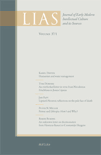
LIAS-Journal of Early Modern Intellectual Culture and its Sources
Exploring the Depths of Early Modern ThoughtLIAS - Journal of Early Modern Intellectual Culture and its Sources is a distinguished academic journal that delves into the rich tapestry of intellectual thought from the early modern period, exploring the interplay between culture, philosophy, and literature. Published by PEETERS in Belgium, this journal serves as a vital resource for scholars and students alike, offering a platform for rigorous research and innovative perspectives in the fields of History, Literature, and Philosophy. With an ISSN of 2033-4753 and an E-ISSN of 2033-5016, LIAS has earned notable rankings in the 2023 Scopus classifications, reflecting its commitment to scholarly excellence and its growing influence within these disciplines. Although it currently does not offer open access options, it is esteemed for publishing high-quality articles that illuminate the complexities of early modern intellectual culture and its enduring impact on contemporary thought. The journal's well-curated content holds significance for researchers keen on exploring interdisciplinary approaches and contributes meaningfully to ongoing educational discourse.

RENAISSANCE QUARTERLY
Connecting Scholars through Renaissance DiscourseRENAISSANCE QUARTERLY, published by Cambridge University Press, is a premier academic journal dedicated to the exploration and scholarship of Renaissance studies, encompassing history, literature, and the visual and performing arts. With an impressive impact factor reflecting its scholarly significance, it holds a distinguished position in the prestigious Q2 quartile across various categories, including History, Literature and Literary Theory, and Visual Arts and Performing Arts as of 2023. The journal caters to a broad audience of researchers, professionals, and students eager to engage deeply with Renaissance scholarship through a curated collection of articles, reviews, and critical essays. Although it does not provide open access options, RENAISSANCE QUARTERLY plays an essential role in advancing the academic discourse of the Renaissance period, fostering connections within the global scholarly community. Since its inception in 1971, it has continuously contributed valuable insights and perspectives on the multifaceted dimensions of Renaissance culture, making it a vital resource for anyone invested in this rich field of study.
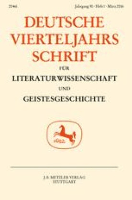
DEUTSCHE VIERTELJAHRSSCHRIFT FUR LITERATURWISSENSCHAFT UND GEISTESGESCHICHTE
Navigating the Rich Landscape of Literary Theory.DEUTSCHE VIERTELJAHRSSCHRIFT FUR LITERATURWISSENSCHAFT UND GEISTESGESCHICHTE, published by J B METZLER, is a distinguished academic journal hailing from Germany that offers a profound exploration of literature, cultural studies, and philosophy. With its ISSN 0012-0936 and E-ISSN 2365-9521, this journal has been operational since its inception in 1973, continually contributing to the intellectual discourse surrounding literary and philosophical theories. The journal holds a recognized position within the academic landscape, achieving a Q3 ranking in Literature and Literary Theory and Q4 in both Cultural Studies and Philosophy as of 2023. Although it does not currently offer Open Access options, its impact in the field is underscored by its ranking in Scopus, where it is recognized amongst a competitive cohort of journals. Aimed at researchers, professionals, and students alike, the DEUTSCHE VIERTELJAHRSSCHRIFT serves as an invaluable resource for those investigating the intersections of literature and the broader cultural milieu, fostering an understanding of the dynamics that shape literary and philosophical thought.

Jahrbuch der Oesterreichischen Byzantinistik
Advancing Byzantine scholarship with every issue.Jahrbuch der Oesterreichischen Byzantinistik, published by the esteemed Österreichische Akademie der Wissenschaften, is a vital academic journal dedicated to advancing the study of Byzantine studies, history, and related fields. Situated in Austria, this journal serves as a critical platform for scholars and researchers, offering a rich collection of articles that reflect the diverse aspects of Byzantine culture, literature, and archaeological findings. Despite its recent categorization in the Q4 quartile in areas such as Archaeology, History, and Literary Theory, it commands impressive rankings within Scopus, particularly in Literature and Literary Theory at the 87th percentile, highlighting its growing impact in the arts and humanities. Researchers and professionals can access comprehensive studies that span from 2010 to 2018 and continue from 2020 to 2023, paving the way for interdisciplinary dialogue and exploration within the Byzantine field. As a continually evolving resource, the Jahrbuch is essential for those committed to deepening their understanding of this historically rich domain.
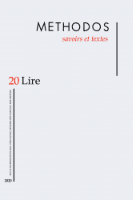
Methodos-Savoirs et Textes
Fostering Interdisciplinary Connections in Academic ResearchMethodos-Savoirs et Textes is a distinguished peer-reviewed academic journal published by UNIV LILLE III-CHARLES GAULLE, UMR SAVOIRS TEXTES LANGAGE. With a focus on interdisciplinary studies in the fields of textual analysis, knowledge dissemination, and language dynamics, this journal serves as an essential platform for researchers, professionals, and students aiming to contribute to and engage with contemporary scholarly discourse. Since its transition to Open Access in 2001, Methodos-Savoirs et Textes has dedicated itself to enhancing the visibility and accessibility of research outputs, encouraging a wider reach and impact within the academic community. The journal is respected for its commitment to rigor and innovation, making it an invaluable resource for those interested in the intersections of text, language, and knowledge. For further exploration of groundbreaking research, you can access the journal online at its official website, where you will find a range of articles that reflect the latest developments in the field.
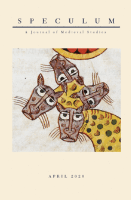
SPECULUM-A JOURNAL OF MEDIEVAL STUDIES
Illuminating the Medieval ExperienceSPECULUM: A Journal of Medieval Studies, published by University of Chicago Press, stands as a premier academic platform within the field of medieval studies. With an impressive legacy dating back to its inception in 1926, this journal has attracted scholarly contributions that explore the rich tapestry of human experience during the medieval period, encompassing areas such as history, literature, philosophy, cultural studies, and the visual and performing arts. It boasts elite rankings—Q1 in History, Literature and Literary Theory, Religious Studies, and Visual Arts and Performing Arts, with a commendable Q2 in Cultural Studies and Philosophy—attesting to its impact and relevance in academia. Although it is not an open-access journal, the rigorous peer-review process and critical scholarship found within its pages provide invaluable insights for researchers, professionals, and students alike. With a substantial Scopus ranking, ID 0038-7134, and E-ISSN 2040-8072, SPECULUM continues to serve as an essential resource for advancing knowledge and understanding of the medieval world, encouraging interdisciplinary dialogue and scholarly interaction.

Artibus et Historiae
Innovating Perspectives on Visual CultureArtibus et Historiae is a distinguished academic journal published by IRSA PUBLISHING HOUSE, focusing on the fields of Visual Arts and Performing Arts within the broader scope of Arts and Humanities. With an ISSN of 0391-9064, this journal has become a crucial platform for the dissemination of scholarly research, critical discourse, and innovative ideas in art history and visual culture. Though its coverage in Scopus was discontinued in 2018, it maintained a respectable ranking of #279 out of 502 in its category, placing it in the 44th percentile. This positions Artibus et Historiae as a respected contributor to scholarly conversations in its field. Researchers, professionals, and students will find valuable insights and analyses that deepen their understanding of artistic practices and historical contexts. While not an open-access journal, it aims to bridge the gap between academia and broader audiences interested in the dynamic interplay of art and history.
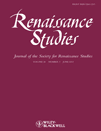
Renaissance Studies
Cultivating a Rich Dialogue on Renaissance HeritageRenaissance Studies, published by Wiley, stands as a vital academic platform within the disciplines of Cultural Studies, History, Literature and Literary Theory, Religious Studies, and Visual Arts and Performing Arts. With an impressive history of publication spanning from 1987 to 2024, this journal is recognized in 2023 metrics as a Q2 journal in four categories and Q1 in Literature and Literary Theory, reflecting its substantial impact in promoting interdisciplinary dialogue and research. The journal's robust Scopus rankings further underscore its relevance, including a position in the 83rd percentile in Literature and Literary Theory. Although not an open-access journal, it provides readers and contributors with access to curated, high-quality scholarship that explores the complexities of the Renaissance and its enduring influence on contemporary thought and culture. Researchers, professionals, and students alike will find Renaissance Studies invaluable in fostering discussions that bridge historical context with modern inquiry.